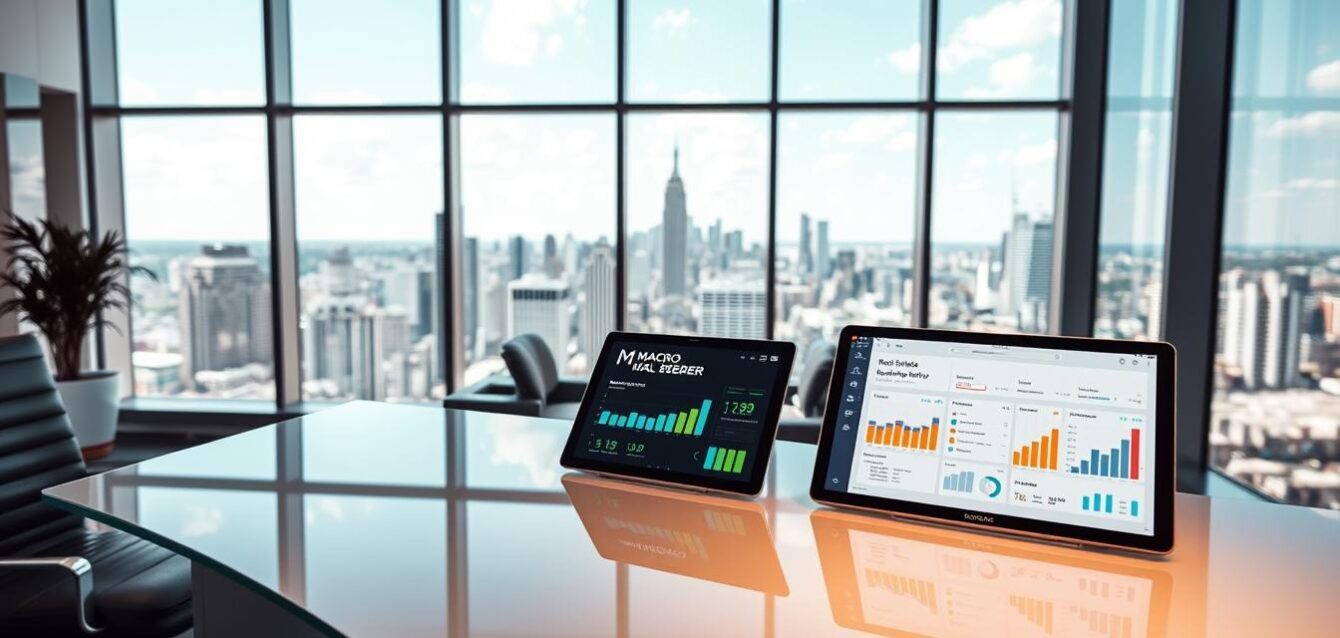Did you know that 72% of top-performing real estate agents rely on multi-platform campaigns to attract serious buyers? The right approach can triple your lead flow while cutting costs. With AI-driven optimizations, some agencies reduce cost-per-lead by 40%—without sacrificing quality.
Macro Webber’s framework helps agents dominate local markets. Their system blends Google, social media, and programmatic ads to target high-intent buyers. One case study showed a staggering $8 return for every $1 spent on Facebook campaigns.
Ready to transform your results? Discover actionable steps at www.macrowebber.com. Whether you’re nurturing sellers or connecting with buyers, data-backed methods make all the difference.
Key Takeaways
- Multi-platform ads attract 3x more serious buyers.
- AI optimization slashes costs while boosting lead quality.
- Targeted Facebook campaigns deliver high ROI.
- Google Business Profile enhances local visibility.
- Macro Webber’s solutions streamline implementation.
Why the Best Ad Distribution Strategy Matters for Homebuyer Leads
Not all marketing efforts deliver the same results—some outperform others dramatically. In real estate, precision matters. Reaching buyers actively searching for homes saves time and boosts conversions.
How Targeted Ads Fuel Lead Generation
Ads that align with user intent convert 47% more often. For example, Google Ads outperform generic social campaigns by 3x. They capture high-intent searches like “homes for sale in Austin” or “top-rated agents near me.”
Avoiding irrelevant impressions is key. Proper placement prevents 68% of budget waste. One agent scaled seller leads by 300% using ZIP code-specific campaigns.
Maximizing ROI with Smart Distribution
Retargeting brings back 28% of lost visitors. Dynamic ads showcasing viewed properties recover 1 in 3 leads. AI-driven bidding further optimizes spend, saving agents $1,200 monthly.
| Platform | Conversion Rate | Cost Efficiency |
|---|---|---|
| Google Ads | 3x higher | High ROI |
| Facebook Retargeting | 28% recovery | Low CPL |
| AI-Optimized Bidding | Stable lead flow | $1,200/month saved |
Key takeaway: Focus on platforms where your audience is already engaged. Quality beats quantity every time.
Understanding Your Homebuyer Audience
32% of today’s buyers are first-timers, requiring specific messaging. Downsizers, meanwhile, prioritize different features—like low-maintenance layouts. Knowing these differences turns casual clicks into conversions.
Pinpointing Pain Points with Personas
Millennial first-timers often struggle with down payments. Your content should highlight financing options. For Baby Boomers, emphasize single-level homes or proximity to healthcare.
- First-time buyers: Use CTAs like “Stop renting—build equity today.”
- Downsizers: Try “Simplify your life with a mortgage-free ranch.”
Leveraging Local Market Data
Neighborhood-specific ads convert 55% better. Tools like Macro Webber’s geo-farming identify ZIP codes with under 6 months of inventory—a seller’s market.
“Agents using hyper-local trends see 3x more engagement.”
Track employer expansions too. A new corporate campus? Target relocating homeowners with ads like “Your new job comes with a dream home.”
Core Components of a High-Converting Ad Strategy
Visuals and messaging determine whether prospects engage or scroll past. To turn clicks into leads, your campaign needs two pillars: standout creative assets and landing pages built for action.

Creative Assets: Images, Videos, and Ad Copy
Video content holds attention 4x longer than static images. Drone footage of listings boosts click-through rates by 140%. Pair visuals with emotional triggers like *”Find Your Dream Home”* instead of generic phrases.
Tools like heatmaps reveal which website elements perform best. Test urgency cues—*”24-Hour Exclusive Access”* often outperforms vague offers.
Landing Pages Optimized for Lead Capture
Optimized pages convert 22% more visitors. Use progressive profiling forms to gather details without overwhelming users. For example, start with just an email field, then ask for phone numbers later.
- Mobile-first design: 67% of buyers browse on phones.
- Clear CTAs: *”Schedule a Tour”* beats *”Learn More.”*
- A/B testing: Try video backgrounds vs. hero images.
“Agents using dynamic lead forms see 3x more conversions than static ones.”
Your marketing wins when creativity meets data. Refine based on what converts, not guesses.
Google Ads: Capturing High-Intent Buyers
Google Ads dominate real estate marketing by reaching buyers at the perfect moment. When someone searches for “luxury homes in Miami,” they’re signaling serious intent—your ad can meet them there.
Keyword Research for Real Estate Campaigns
Specific terms like *”motivated seller homes”* convert 8x better than generic ones. Use tools like Google Keyword Planner to find high-volume phrases. Focus on seasonal trends—spring listings often spike searches for *”move-in ready.”*
- Bid on *”new construction [city]”* during development booms.
- Dynamic Search Ads fill gaps in your MLS keyword list.
Hyper-Local Targeting Techniques
ZIP code campaigns reduce cost-per-click by 35%. Target areas near new transit hubs—buyers prioritize commute times. Radius ads around popular schools or parks also perform well.
“Agents using 1-mile radius ads see 50% higher engagement than city-wide campaigns.”
Retargeting Past Website Visitors
28% of leads return after seeing retargeted ads. Custom audiences work best—show properties they viewed or similar listings. Video viewers? Follow up with a virtual tour of their favorite home.
Pro tip: Exclude users who already converted to save budget.
Social Media Advertising: Facebook & Instagram
Social platforms now drive 62% of real estate inquiries—are you maximizing their potential? With buyers spending 20+ hours weekly on apps like Instagram, your marketing needs to stand out. Targeted ads here convert 3x faster than email campaigns.
Building Lookalike Audiences for Scalable Leads
Upload your past client list to Facebook Ads Manager. The algorithm finds users with similar interests, expanding your audience effortlessly. One agent grew leads by 200% using this tactic.
Exclude existing contacts to avoid wasted spend. Layer in income filters for luxury listings or first-time buyer programs.
Engaging Ad Formats: Carousels, Videos, and Lead Forms
Carousel ads showcase 4+ properties in one swipe. They earn 40% more clicks than single images. Pair them with captions like *”Which of these kitchens fits your style?”*
Instagram Reels demo neighborhoods in 30 seconds. Use trending audio to boost reach. For direct leads, Facebook’s auto-fill forms cut contact costs by 60%.
| Ad Type | Engagement Rate | Best For |
|---|---|---|
| Carousels | 40% higher clicks | Property showcases |
| Lead Forms | 60% lower CPL | Instant inquiries |
| Video Testimonials | 2x more trust | Brand credibility |
Pro tip: Run polls like *”Modern or Traditional?”* to spark interactions. User responses refine your audience targeting.
YouTube Ads for Storytelling and Trust-Building
Video storytelling now drives 42% of real estate decisions—are you leveraging it? YouTube’s skippable ads convert best with 15-second teasers, blending urgency and curiosity. Platforms like this turn passive scrollers into motivated leads.
Creating Compelling Video Hooks in 5 Seconds
Grab attention fast. Open with bold statements like *”This $800k Home Has a Secret Rooftop Oasis.”* Use cliffhangers to keep viewers watching:
- Show, don’t tell: Drone shots of backyards outperform static images.
- Chapter markers: Let users jump to key features (e.g., “3:00 – Chef’s Kitchen”).
Using In-Market Audiences for Buyer Intent
YouTube’s in-market audience targeting identifies users actively searching for homes. These groups convert 2.3x more often. Retarget those who watch 75% of your video with CMA offers—*”Your Dream Home Awaits.”*
“TrueView ads ensure you only pay for engaged views, slashing wasted spend.”
Sync campaigns with Google Display Network for wider reach. Test emotional triggers like *”Imagine Your Family Here”* versus practical benefits like *”Walk to Top-Rated Schools.”*
TikTok Ads: Reaching Next-Gen Homebuyers
Short-form video isn’t just for dances—it’s reshaping how buyers discover properties. With 30-second home tours outperforming longer content, TikTok offers a goldmine for real estate professionals. Spark Ads alone boost organic reach by 140%, making this platform a must-test.
Leveraging Trending Sounds and Challenges
Viral trends drive engagement. Try these tactics:
- #DreamHomeChallenge: Encourage user-generated tours of their ideal spaces.
- Agent transitions: Swap from casual attire to professional wear—a proven hook.
- Local influencers: Partner with creators for neighborhood guides tagged #FirstTimeHomeBuyerTips.
One agent’s “Before/After” renovation clips gained 500K views, resulting in 22 leads.
Retargeting Engaged Viewers
Users who watch 50%+ of your videos signal high intent. Retarget them with:
“Dynamic ads showcasing down payment calculators convert 35% of hesitant renters.”
Exclude converted users to maximize budget efficiency. Layer income filters for luxury real estate campaigns.
Pro tip: Use TikTok’s “TopView” ads for prime placement—the first thing users see when opening the app.
Programmatic Display Ads for Wider Reach
Dynamic ads adapt to user behavior, boosting conversions by 3x. Unlike static banners, these real estate tools show properties based on browsing history. For example, a buyer viewing condos sees related listings across partner websites.
Placement Strategies on Real Estate Websites
Target users browsing Zillow or Redfin with competitor ads. Portal placements convert 18% better than generic networks. Focus on high-traffic pages like:
- Search results: Capture active searchers.
- Property details: Retarget engaged visitors.
- Neighborhood guides: Attract location-focused buyers.
“Agents using weather-triggered ads (e.g., pool homes during heatwaves) see 22% higher engagement.”
Dynamic Ads for Personalized Property Showcases
AI updates listings in real time. Price drops? Your ad reflects it instantly. Tools like Realtor.com’s API sync MLS data to banners, ensuring accuracy.
Retarget apartment website visitors with down payment assistance offers. Pair dynamic creatives with urgency: “Only 2 left at this price!”
| Tactic | Impact |
|---|---|
| Weather-triggered ads | 22% engagement lift |
| AI-generated descriptions | 40% faster ad production |
| Competitor retargeting | 3x conversion boost |
Pro tip: Use brand colors in creatives for instant recognition across platforms.
Optimizing Ads with AI and Automation
AI transforms how *real estate* professionals attract and convert *leads*. By automating repetitive tasks, you focus on closing deals while algorithms handle precision targeting. Case studies show a 40% drop in cost-per-lead with smart bidding—proof that data beats guesswork.

AI-Powered Bidding Strategies
Platforms like Google Ads use machine learning to adjust bids in real time. Predictive models analyze:
- Time of day: Target *audiences* when engagement peaks.
- Device types:
Mobile users get 67% of *real estate* searches. - Competition levels: Avoid overbidding during low-activity periods.
“Agents using AI-driven budgets see 22% more conversions with identical spend.”
Automated Personalized Recommendations
Dynamic *ads* now tailor property suggestions based on browsing history. For example:
- Chatbots qualify *leads* by asking budget/needs, then route them to agents.
- Natural language processing tests 100+ ad copy variants to find top performers.
- Drip campaigns send AI-curated listings—like waterfront homes after a lake search.
Macro Webber’s AI Ad Suite syncs these *tools* into one dashboard. It auto-pauses underperforming campaigns and scales winners—saving 10+ hours weekly.
Measuring Success: Key Metrics to Track
Tracking the right metrics separates thriving agents from those wasting budgets. In real estate, data-driven decisions cut costs while boosting quality leads. Focus on indicators that reveal true campaign health—not just vanity numbers.
Cost Per Lead vs. Conversion Rates
Top agents maintain under $50 CPL for Google Ads. But low costs mean nothing if leads don’t convert. Balance both metrics:
- Impression share: Track visibility vs. competitors in high-demand ZIP codes.
- Lifetime value: A $100 lead earning you $5,000 in commissions outweighs ten $20 leads that ghost.
“CRM integrations boost lead conversion by 27% by automating follow-ups.”
Essential Tools for Ad Analysis
Smart tools turn raw data into actionable insights:
- Multi-touch attribution: See which ads drive decisions across devices.
- Automated UTM tracking: Tag sources to identify top-performing platforms.
Benchmark against real estate dashboards like Macro Webber’s. Their performance grids show average:
3.2% conversion rates for retargeting campaigns and 18-second optimal video watch times.
| Metric | Healthy Range | Alert Threshold |
|---|---|---|
| CPL (Google Ads) | $30-$50 | Above $75 |
| Form Completion Rate | 22%+ | Below 12% |
| ROAS (Facebook) | 4x+ | Under 2x |
Refine your strategy weekly. Small tweaks based on these numbers compound into massive results over time.
Conclusion
Your real estate success hinges on consistent lead flow—here’s how to maintain it. A 12-month roadmap ensures sustainable growth, blending Google Ads, social retargeting, and AI optimizations. Macro Webber’s framework helps agents achieve 3-5x ROI, turning clicks into commissions.
Ready to refine your approach? Schedule a free audit today. Call +91 (353) 405-7665 or visit www.macrowebber.com. For a limited time, download our AI Ad Optimization Kit—no strings attached.
Cultivating solutions to transform your real estate business. Let’s grow together.



